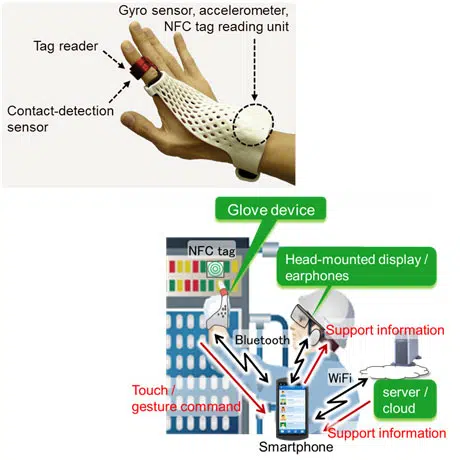
A new glove-style wearable device that combines an NFC tag reader, gyro sensor and accelerometer is to be demonstrated by Fujitsu Laboratories at Mobile World Congress 2014. Aimed at maintenance and other on-site operations, it will enable workers to touch the NFC tag on an item they are working on to get information about it and then input data about the work they have performed using simple gestures.
“Smartphones, tablets and other smart devices have made work more efficient by digitizing the process of activity logging, and attempts have been made to use them to support work outside of office environments,” the company explains.
“But in some work settings, such as those that require gloves to be worn or environments in which hands get dirty, taking out and using a conventional smart device can be difficult. Another hurdle is that users need to stop what they are doing to use their smart device.
“With the Fujitsu Laboratories-developed wearable device, users can receive work instructions and other information, just by the natural action of touching an object. Task results can also be input using gestures so operations can be carried out smoothly.”
“Wearable devices need to be comfortable without placing a burden on the user’s body, and for that reason, they cannot have bulky batteries,” Fujitsu adds. “Accordingly, low-power operation is a prerequisite. For the glove device, by equipping the operator’s finger with a touch sensor and activating the NFC tag reader only for the moment the object is touched, power consumption is kept low.
“This gives the glove device nine hours of runtime, compared to three hours for a device that lacks this kind of operating time power control. This longer battery life is sufficient for an entire workday.”
The company says the gesture recognition technology “takes note when the wrist is in a dorsiflexed position, where the hand rotates back, a movement that is not common in everyday tasks, and activates on that position, so that it can distinguish between normal arm movements and gestures.
“It also defines gestures based on the shoulder as the centre of a coordinate system. This accommodates variations between individuals and allows gesture-based inputs in a variety of positions without awkwardness.
“In-house testing showed that six patterns — up, down, left, right, rotate left, rotate right — could be recognized with 98% recognition accuracy. These gestures could be used to flip through pages of a manual being shown on a head-mounted display with left and right motions, or to scroll with up and down motions. In a scenario where it is used to input work status, a right rotation could indicate a normal state, and a left rotation a problem.”
The next step for the new device, Fujitsu says, is “to perform verification testing on the technology with the aim of bringing a product to market in fiscal 2015.”
Next: Visit the NFCW Expo to find new suppliers and solutions